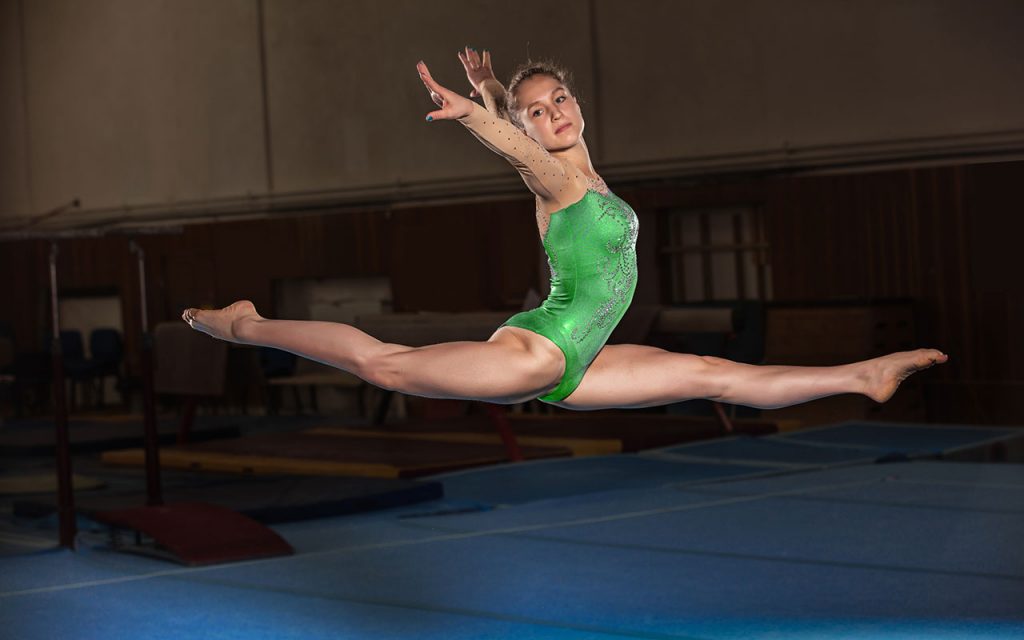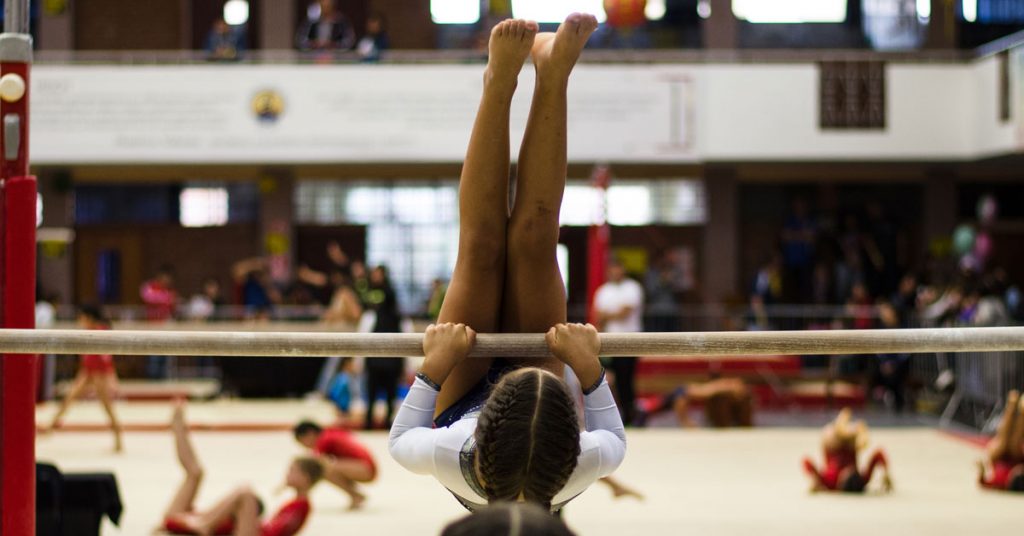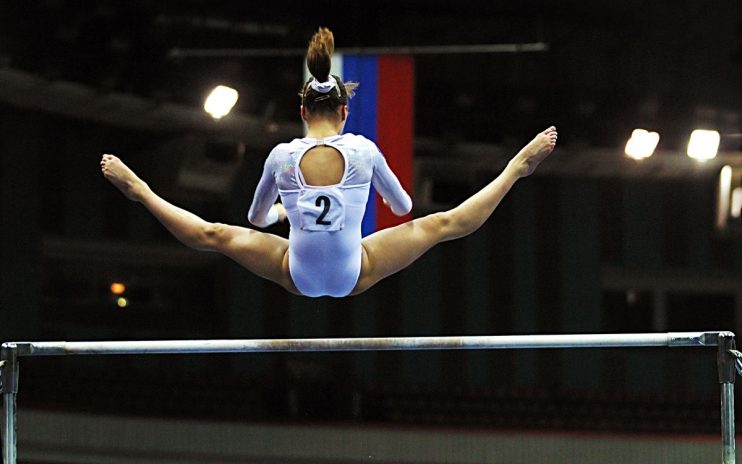Gymnastics levels are designed to help gymnasts understand where they are in their skills and serve as a guide for which skills a gymnast should learn next. Levels also determine which competitive events a gymnast can participate in.
There are two programs: Junior Olympic and Xcel, that gymnasts usually advance through. Each program has its own set of requirements.
This guide will take a deep dive into each of these programs to help you understand how the two programs differ and what skills are required at each level.
In gymnastics, the JO program is designed for gymnasts who are passionate about the sport and are looking to prepare for advanced competitions or aiming for the Olympics. The Xcel program is for those who love the sport but have no plans of getting involved in the more advanced competitions. Both are a great way for gymnasts to progress.
Junior Olympic (JO) Program vs. Xcel Program
Most gymnasts in the United States develop their skills through either the JO or Xcel program. While both require certain skills for advancement, there are quite a few differences in the nature of the programs.
Each program has optional and compulsory levels. At the compulsory level, the gymnast must perform a standard routine, while at optional levels, the gymnast can perform individualized, choreographed routines. For each program, the skill level will vary as to when gymnasts can perform optional routines.
JO Program
The JO program is designed for gymnasts who are serious about competitions and their future careers. Gymnasts who enter this program want to eventually compete at higher levels and may want to go professional or even compete in the Olympics.
Each level has strict requirements. Gymnasts in the JO program work harder and have frequent practices. They’re expected to improve their skills consistently and must demonstrate a high level of discipline. Most gymnasts in the JO program start in the sport at a young age, or if starting older, have incredible talent and the ability to move through the levels quickly.
Xcel Program
The Xcel program is designed for gymnasts who have a passion for the sport but don’t plan to compete at higher levels. These gymnasts may have found the sport at an older age or may just want to learn casually without engaging in frequent, intense practices.
Xcel regulations aren’t as strict, and gymnasts can move through the divisions at their own pace. There are competitions for gymnasts who participate in the Xcel program, but they aren’t as competitive or serious as those in the JO program. The Xcel program is ideal for gymnasts who don’t have the skill or time to participate in the JO program.
How Many Levels Are There in Gymnastics?
In the JO program, there are ten levels. Once a gymnast has mastered all ten levels, they can move into the Elite level, which is usually the equivalent of going pro or training for the Olympics.

There are five levels in the Xcel program, ranging from Bronze to Diamond. The Diamond level, which is the highest, is equivalent to Level 7 in the JO program. Gymnasts in the Xcel program who decide they want to get more serious can move into the JO program, but it’s not an easy feat.
JO Program Levels
The JO program is comprised of 10 levels. Gymnasts must meet a set of requirements before advancing to higher levels. Requirements are based on the four main events: uneven bars, balance beam, floor routine, and vault.
Gymnastics Level 1-3
The first three levels aren’t competitive. These levels are designed for gymnasts who are just beginning the sport and need to learn foundational skills. Gymnasts at Levels 1-3 are usually younger but don’t have to be.
Routines in Levels 1-3 are compulsory, meaning that there are standard routines that all gymnasts must master before moving on to the next level. Gymnasts can compete with routines in these levels, but it’s not typical.
Level 1 Requirements
To reach Level 1, a gymnast must complete a floor routine with a forward and backward roll, cartwheel, split jump, and a three-quarter handstand.
On beam, the gymnast must complete a jump to front support mount, stretch jump, 30-degree arabesque, lever, stretch jump, and dismount by way of cartwheel to three-quarter handstand.
The vault requirements are a basic stretch jump onto the mat, a kick up into a handstand, and a fall to flat back
On the bars, gymnasts must be able to do a cast, pullover, and back hip circle. For the dismount, they have the option of doing an underswing or a sole circle.
Level 2 Requirements
Level 2 floor requirements include a round-off and backward roll. Gymnasts must do a handstand and hold it for at least one second. Jumps include a split jump and split leap, both with a 60-degree leg separation. Finally, the routine must also include a 90-degree heel snap turn and a bridge back kick-over.
For the beam, gymnasts must jump to front support mount, stretch jump, lever, and arabesque as in Level 1. They must also complete a half-pivot turn and a more complicated dismount: a cartwheel to side handstand.
For the vault, gymnasts have to do a jump to a handstand from the mat stack and a fall to a flat back.
The bar routine must include a cast, pullover, and back hip circle, just as in Level 1. It must also include a mill circle, leg cut, and single-leg basket swing. The dismount can be an underswing as before, or, for more ambitious gymnasts, a squat to pike sole-circle.
Level 3 Requirements
In addition to the requirements for Level 3, gymnasts must also be at least six years old to compete.
The floor routine must include a handstand to bridge kick-over and a handstand forward roll. Jumps include a split jump and a 90-degree split leap. Gymnasts must do a backward roll to a push-up and a round-off to a back handspring, which is often the first major accomplishment for young gymnasts.
The beam routine must include a 90-degree split jump and a straight jump. Gymnasts also have to do a handstand and dismount with a side handstand.
The gymnast must perform a handstand with a flat back onto a stack of mats for the vault.
The gymnast must do a front and back hip circle, a pullover, and a single-leg squat through for the bars. They must perform a single-leg basket swing or a mill circle and dismount with an underswing.
Gymnastics Level 4
Level 4 is typically the first level where gyms allow their gymnasts to compete. All routines at Level 4 are compulsory, so gymnasts aren’t able to perform individualized routines.
Level 4 Requirements
The floor routine includes a straddle jump with a 120-degree split and a front handspring landing on two feet. Gymnasts must perform a back walkover and back extension roll. Finally, they must add an extra back handspring to their round-off back handspring.
For the beam, gymnasts must complete a split leap and a split jump, both to 120 degrees. Other requirements include a cartwheel and a handstand. The dismount must be a cartwheel to a side handstand and then a quarter-turn dismount.
The vault is a basic front handspring; this level is the first where the gymnast must land on their feet.
On bars, the gymnast has the option between a pike glide kip or straddle. They must also do a long hang kip, back hip circle, and squat on. Finally, the routine must include a cast to horizontal.
Gymnastics Level 5
Before competing at Level 5, a gymnast must be at least seven years old and have scored at least a 34 AA at a Level 4 meet. Level 5 is also compulsory.
Level 5 Requirements
The floor routine will include three jumps: a stretch jump with a full turn, a straddle jump, and a split leap. Gymnasts will perform a full turn and a front tuck.
On beam, gymnasts must do a straight leg leap at 150 degrees and a split jump. A sissonne is required along with either a back walkover, back extension roll, or back handspring with step out. The dismount is a cartwheel into a side handstand and then a quarter turn.
For the vault, the gymnast will do a front handspring as in Level 4.
The bar routine gets much more complex with a kip, long hang kip, and a long hang pullover. Gymnasts must also do a clear hip to above horizontal and a cast to above horizontal. They must perform a backward sole circle and a back sole circle or a back stalder circle to clear front support. The routine must include a squat on and tap swings and must end with a flyaway dismount.
Gymnastics Level 6
Level 6 marks the beginning of optional routines and is often an important benchmark for many gymnasts. Gymnasts will need to meet all of the Level 6 skills and include at least five A skills and 1 B skill in their routines. All gymnastics skills are ranked from A to E, with A being easier skills and E being the most challenging.
A gymnast may be able to skip Level 6 altogether if they scored a 32 AA at Level 5.
Level 6 Skills
For the floor routine, the gymnast must do an acro series that includes at least three elements, two of which with flight. They can do either an aerial acro element or a salto. There must also be a dance passage with at least two different jumps, leaps, or hops. At least one of these must involve a 180-degree split. Finally, the routine will need a full turn on one foot.

On the beam, the gymnast has an option of an acro series without flight or at least one acro element with flight. They must do a full turn on one foot and either a jump or a leap with a 180-degree split. They must dismount with one of the A-level elements.
For the uneven bars, the gymnast must make at least one bar change and cast to at least 45-degrees above horizontal. They must do a full circle and can choose between a Hecht, stalder or clear hip circle, or underswing.
Gymnastics Level 7
At Level 7, the gymnast must have at least five A skills and two B skills in their routines.
Level 7 Skills
The floor routine will include an acro series with at least three flight elements and a back layout. The gymnast must also do a front acro series with two skills, one of which must be aerial or salto. They’ll also do a dance passage containing two skills, a 180-degree split leap and a full turn on one foot.
The beam routine must also have an acro series with at least two skills and an acro flight element. They must do a full turn on one foot and a jump or leap with a 180-degree split. Finally, the dismount is an aerial or salto that is ranked as an A skill.
For the vault, the gymnast can choose between a front handspring, a quarter to half twist Tsuko, or round-off entry, both with a landing on the mat stack.
For bars, the routine must include a cast to handstand and at least two full circling skills, one of which is a B skill. The dismount must be an A-level salto.
Gymnastics Level 8-10
Levels 8-10 are the advanced levels with more challenging skills and difficult competitions.
Level 8 Skills
At Level 8, gymnasts must do at least four A and four B skills. On floor, the acro series must have two saltos and three different saltos throughout the routine. There must be a dance passage with at least two different hops, jumps, or leaps.
On beam, the acro series must have at least two skills, and one must involve flight. There should be one complete turn on one foot and an A-level salto or aerial dismount. The vault must be at least a front handspring vault.
For bars, there should be at least one bar change, a B-level skill with a turn or flight, and a B-level circle or swing. The dismount must be a salto with A-level elements.
Level 9 Skills
To get to Level 9, a gymnast needs a 34 AA at Level 8 and must be at least eight years old. Routines need at least three A skills, four B skills, and one C skill. The floor requirements are the same as Level 8, but the full turn on one foot and last salto has to be at B-level.
The beam is also the same but must now include a B-level salto or aerial dismount. There must also be a dance sequence with at least two skills. At Level 9, gymnasts will look to the Vault Chart to choose a vault.
The bar routine will incorporate two bar changes and both B-level and C-level flight skills. The salto dismount must be valued at least as a C.
Level 10 Skills
At this level, the gymnast must be at least nine years old and have a 34 AA at Level 9. They must include three A, three B, and two C skills. The Level 10 floor routine is the same as Level 9, except the final salto must now be C-level.
The beam is also the same but gets more challenging with a C-level dismount. The vault routine must be chosen from the Level 10 Vault Chart. The bars are also similar, but now include at least one C-level flight skill and a longitudinal-axis turn skill.
Elite Level
At the Elite level, the gymnast can compete in professional competitions or may be training for the Olympics.

Xcel Program Divisions
The Xcel program has five divisions.
Bronze
At Bronze Level, the floor routine must have at least two connected acro moves, a dance passage with a 60-degree leap and one other skill, and a half turn on one foot. There must also be a second passage with at least one skill.
For beam, the gymnast must do a half-turn on two feet, a leap or jump, one acro skill, and a dismount. On vault, the gymnast can either do a stretch jump onto the mat and kick to handstand or jump straight to a handstand.
The bar routine must include at least four A skills, including a cast and circle skill and a dismount.
Silver
The Silver Level builds on the Bronze level. The floor routine must now include at least one flight skill in the connected acro skills, and there must also be a second pass with at least two skills or one flight skill. The one-foot turn is now 360-degrees.
On beam, the half-turn must be on one foot. The jump or leap must be 90 degrees. The vault requires either a handspring over the mats or a half to quarter on the beam with a landing facing the beam.
The bar requirements are the same, only gymnasts now need five A-level skills.
Gold
At Gold Level, skills become more challenging. On the floor, both acro skills must include flight. The second pass must have two connected skills or a salto, and the dance passage must have a 120-degree leap.
For beam, the one-foot turn is now 360 degrees. There must be at least two different dance skills and two acro skills, one of which goes vertical. The vault has to be a front handspring. On bars, gymnasts will need at least six A-level skills and must dismount from the high bar.
Platinum
At the Platinum Level, the floor routine requirements are almost the same as Gold but now requires at least six A skills and one B skill. Gymnasts will also need six A skills and one B skill on beam.
The vault is the same with a front handspring. Bars also need six A skills and one B skill, and the gymnast must perform a kip.
Diamond
Diamond is the highest in the Xcel program, and gymnasts will need at least a 32 AA at the Gold Level. On floor, the gymnast will need five A and two B skills. They’ll need two acro connections and two dance passages. The foot turn must be B level.
Beam requires five A and two B skills. They’ll need an acro skill with flight and an acro series. The dismount must be an aerial or a salto. The vault is still a front handspring. On bars, the gymnast needs five A and two B skills. They’ll need a clear support skill and a pirouette, release, or different circling skill and either a Hecht or salto dismount from the high bar.
Conclusion
In gymnastics, the JO program is designed for gymnasts who are serious about the sport and are preparing for advanced competitions like the Olympics. The Xcel program is for those who love the sport but have no plans of getting involved in advanced competitions.
No matter which path a prospering gymnast chooses, both programs offer a chance to enjoy fully enjoy the sport
Did you enjoy this guide or find it helpful? Let us know in the comments and share it with others!


3 Comments on “The Complete Guide to Gymnastics Levels”
this was great for me because i am a 13 year old xcel gold gymnast and i was wondering if i could be in platinum or diamond! this helped a lot thanks:)
Pingback: How Many Gymnastics Levels are There? - Lake City Twisters
I am on excel silver and I see compulsory training and getting pushed and learning new things every day. Compulsory is being spotted while our coaches are just telling excel do it I can even do it is so easy. Compulsory is recommended.